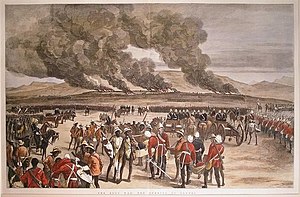Battle of Ulundi
| Battle of Ulundi | |||||||
|---|---|---|---|---|---|---|---|
| Part of Anglo-Zulu War | |||||||
 The Burning of Ulundi |
|||||||
|
|||||||
| Belligerents | |||||||
|
|
Zulu Kingdom | ||||||
| Commanders and leaders | |||||||
|
|
Ziwedu kaMpande | ||||||
| Strength | |||||||
| 4,200 British 1,000 Africans Two Gatling Guns 10 cannon |
12,000-15,000 | ||||||
| Casualties and losses | |||||||
| 13-18 killed 69-85 wounded |
473 killed 1,000+ wounded |
||||||
The Battle of Ulundi took place at the Zulu capital of Ulundi on 4 July 1879 and was the last major battle of the Anglo-Zulu War. The British army broke the military power of the Zulu nation by defeating the main Zulu army and immediately afterwards capturing and razing the capital of Zululand, the royal kraal of Ulundi.
As a result of the decisive Zulu victory at the battle of Isandlwana in January over Chelmsford's main column and the consequent defeat of the first invasion of Zululand, the British found themselves forced to launch a new invasion of Zululand. In April 1879 despite recent battles at Kambula and Gingindlovu which had resulted in serious losses for the Zulus, the British were back at their starting point. News of the defeat at Isandlwana had hit Britain hard. In response, a flood of reinforcements had arrived in Natal with which Chelmsford prepared a second invasion of Zululand. Lord Chelmsford was aware by mid June that Sir Garnet Wolseley had superseded his command of the British forces. Chelmsford was ordered by Her Majesty's Government to "...submit and subordinate your plans to his control." Chelmsford ignored this and various peace offers from Cetshwayo in order to strike while the Zulu were still recovering from their defeats and to attempt to regain his reputation before Wolseley could remove him from command of the army.
For his renewed offensive Chelmsford's overall strength was increased to 25,000. However, the very size of the force overwhelmed the supply and transport capacity of Natal and Chelmsford would have to utilize a number of troops that could be sustained in the field. In the event, for his main column, he fielded two cavalry regiments, five batteries of artillery and 12 infantry battalions, amounting to 1,000 regular cavalry, 9,000 regular infantry and a further 7,000 men with 24 guns, including the first ever British Army Gatling gun battery. The lumbering supply train consisted of 600 wagons, 8,000 oxen and 1,000 mules. The structure of the force was reorganised; Colonel Evelyn Wood’s No. 4 column became the flying column, Colonel Charles Pearson was relieved of command by Major General Henry Crealock and his No.1 column became the 1st Division and Major General Newdigate was given command of the new 2nd Division, accompanied by Lord Chelmsford himself.
...
Wikipedia
